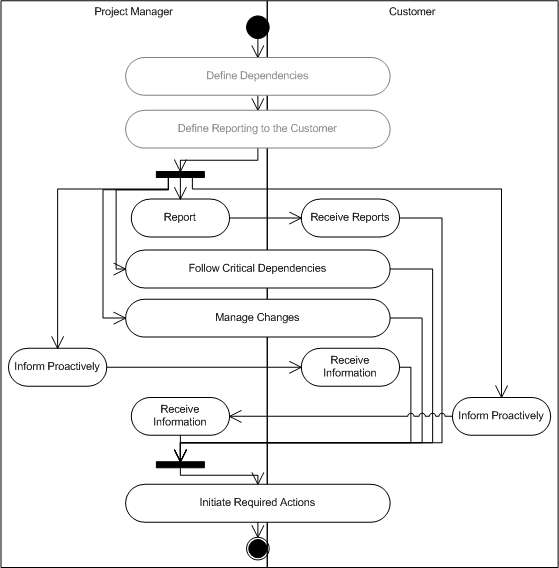| Problem | Customer and supplier not having adequate common understanding about the project status and/or not communicating adequately about changes in both organizations affecting the project through interdependencies. |
| Initial Context | Shared Understanding (KSP05) exists of the aimed results. A Schedule Baseline (KSP09) has been created and Progress is Followed (KSP25). |
| Roles | A Project Manager managing a project and a customer representative. |
| Forces | To cooperate successfully with the customer to create solutions to customer's needs a mutual understanding must exist about the work status of a project. The results and also the intermediate results of the project have been scheduled and may affect other activities in the organizations. Also the project may need something (e.g. certain software modules) from the customer and if the schedule of those changes, the project needs to revise the schedule.
It is not necessary that the customer knows everything that happens in the project but the customer should know the most critical matters adequately to trust the statements of the project manager and to follow the progress. Open honest communication between the customer and the supplier creates a good basis for mutual trust. Of course, real actions and results need to support the messages and prove those correct. |
| Solution |
This is actually a continuous activity which starts again from step 3. If there are bigger changes in the project, steps 1 and 2 might be also needed. |
| Resulting Context | A project where both customer and supplier have adequate understanding of the project and its status including possible effects on other dependent activities. |
| Instances | To be implemented for each new project. The reporting and follow-up continues throughout the project.
One possible pitfall is that an adequate level of open communication is not reached and one or both organizations try to hide things from each other. This is very possible especially if e.g. the customer does not want to invest any time in this or if there are big problems in the project and not courage enough to open the problem to the other party. |
| Process Connection | Project Management, project establishment and realization. |
